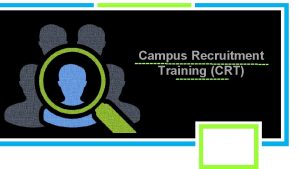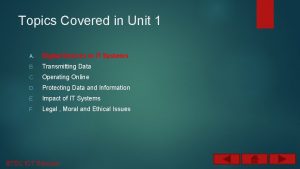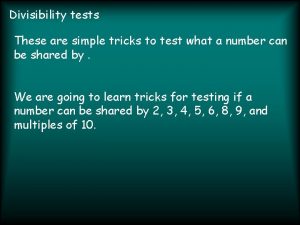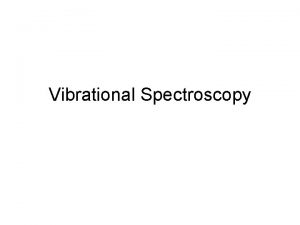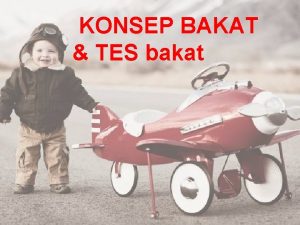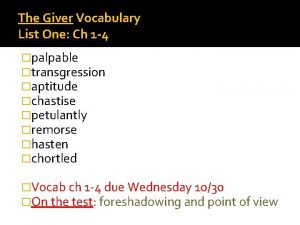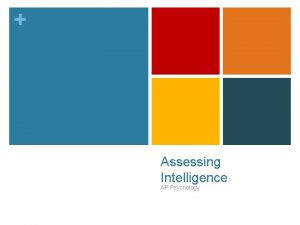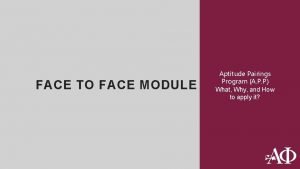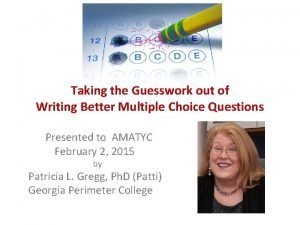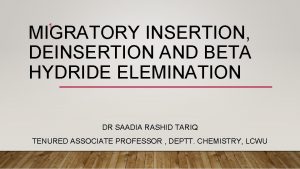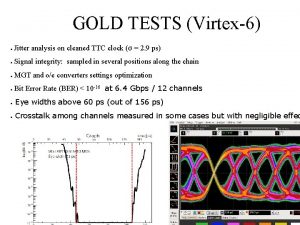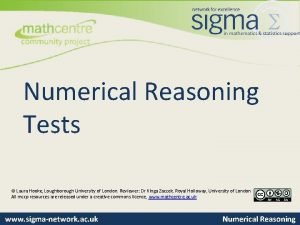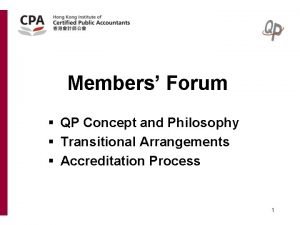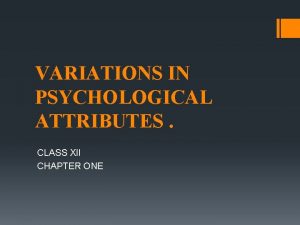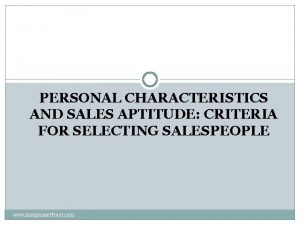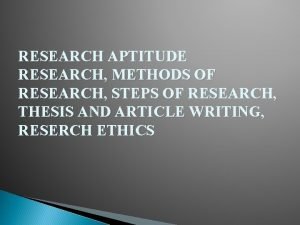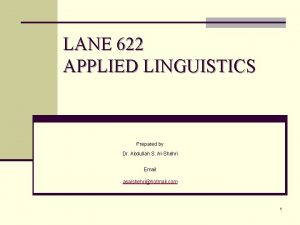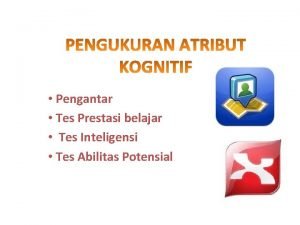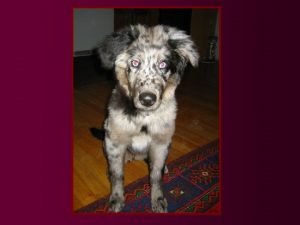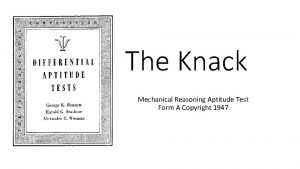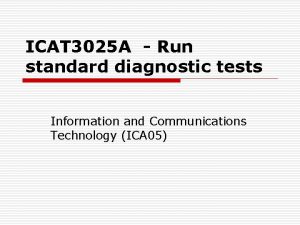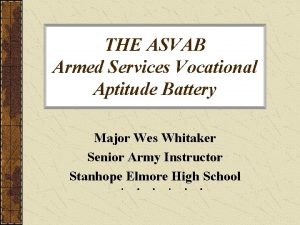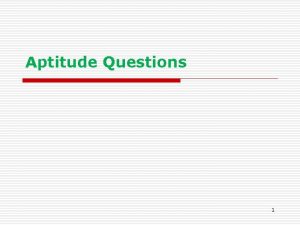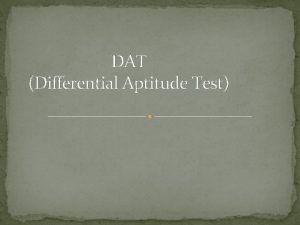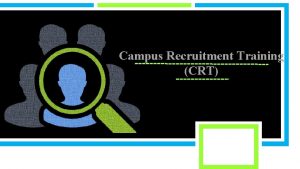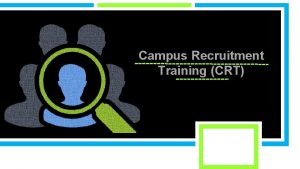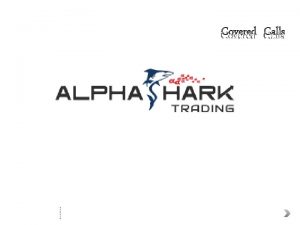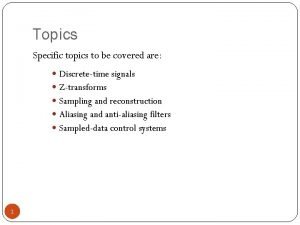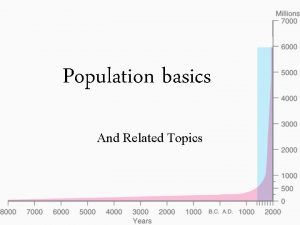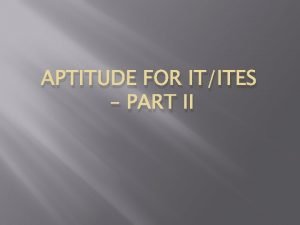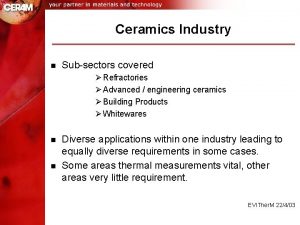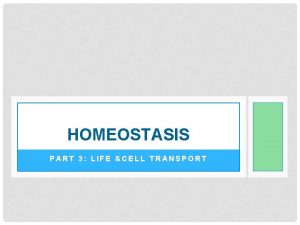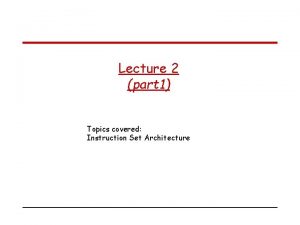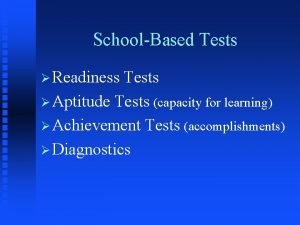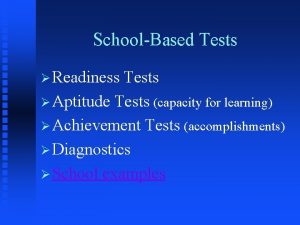APTITUDE FOR IT ITESPLACEMENT PART I Topics Covered



















































- Slides: 51

APTITUDE FOR IT, ITES(PLACEMENT) PART I

Topics Covered � Clearing aptitude with Flying Colors � Handling Technical Interviews � Solved Aptitude Questions from Top companies(HCL, Infosys, Capgemini).


Clearing your Aptitude Test with flying colors Practice Aptitude tests online. It’s more than likely you’ll sit your aptitude test on a computer so get used to practicing them online. Get all the right tools. Ensure you have a good calculator, lots of rough paper, a few pens and a watch. Get used to practicing with all these essentials so you’re used to using them when it comes to your real assessment. Practice as many aptitude tests as you can before sitting your assessment. The more questions you practice the more confident you will be and the more types of questions you will have seen.

Ask the assessor for information on the type of test you’ll be sitting. You have the right to ask what sort of aptitude test you’ll be expected to sit, how long it will be and where you’ll have to sit it. Make sure you’re in a comfortable environment when you practice your aptitude tests. Don’t sit them just before going out or when you’re going to be disturbed. It’s important to give them your full attention both when practicing and when taking your real assessment. Take the practice test offered by the assessor if possible. Before sitting aptitude tests you’ll often be given practice questions to have a go at. They’re normally called worked example, have a go at those to get a flavour for the type of questions you’ll be given.

Read any guidance provided before sitting your assessment. Make sure you make a note of how much time you have and roughly how long you should be spending on each question. Don’t get bogged down on a question. If you get stuck, don’t let the clock run down, move on, you might find the next question easier and you’ll pick up more marks by moving on. Move on. If you think a question is going to take a really long time, flag it and if possible come back to it. Some questions can be really time consuming and you may be better off coming back to it.

Don’t guess wildly. Your aptitude test score will be made up of a combination of speed and accuracy. It’s important not to haphazardly guess to try and finish all the questions. Work carefully and as quickly as you can. The more questions you practice the quicker you will get. Read Questions Carefully. Spend a few seconds familiarising yourself with the graph/table/pie chart you’re presented with before launching into the question. Make a mental note of what the labelling on the axis and the title so you have an idea of what information you have been provided with. Get used to working on paper. The quickest way to do your calculations is on a piece of paper. We recommend using a big A 4 sheet as you’ll have enough room to do your workings. Leave yourself plenty of space so you’re not cramming your workings into the corner

Request feedback on your performance from your assessor. Find out how many questions you got right and where you could improve. Use a good calculator. Make sure calculator /cell phones can be used. Don’t use your phone or a very small calculator. Make sure you are familiar with the calculator you’re using and comfortable with where all the buttons are. The quicker you are with your calculator the higher you will score.

Getting Ready for Technical Interviews Check the profile of the company you are applying for. It helps if you already know about the company, their area of business so you can prepare for the Interview accordingly. While applying for jobs check which skill and what level is expected. Eg. For an Embedded System Engineer with less than one year experience, you may be asked more questions on the Systems c, c++, linux , OS fundamentals. For application oriented jobs you may be asked more questions on the Packages /projects that you have worked with. In a technical interview it is likely that the questions you face may be on topics that you may be asked to choose. Majority of the companies question the candidate on the areas most comfortable to them.

Be ready to write code samples and write them neatly and slowly. There is no need to rush with the answers. Do not give wrong answers for questions you do not know. Remember everyone cannot know everything. Remain calm so that you can focus on complicated technical questions. Be clear in communicating the type of project work that you have done. For a fresher who does not have the work experience, questions may sometimes be asked on the project work and the package /language used for it. Refresh yourself on the project details before appearing for interview.

Aptitude Areas *Arithmetic Progression & Geometric Progression *Pipes & Cisterns *Permutations and Combinations *Perimeter and Area *Numerical Ability *Indices & Surds *Men & Work *Algebraic Equations *Depreciation *Logarithms *Averages *Simple Interest and Compound Interest *Ratio and Proportion

Arithmetic Progression & Geometric Progression

A boy drops a bouncing toy from 1 st floor to ground floor. Each time, it bounces vertically to a height of 1/2 of the preceding bounce's height. Find the distance the toy will cross if it totally takes 6 bounces and the distance between each floor is 10 m. a)39 m b)30 m c)40 m d)15 m

Solution : b) The distance between two floors is 10 m. The boy dropped the bouncing toy from a height of 10 m. As the toy is initially dropped, the toy falls 10 meters. Then, the toy rebounds to 10 x 1/2 = 5 meters and falls back down 5 meters. This process will repeat for 5 more times. Then: Distance that the toy travels down =10 + 10 x 1/2 +. . . + 10 x(1/2)6 = 10 + 10 x(1/2)1 + 10(1/2)2 + 10(1/2)3 + 10 x(1/2)4 + 10(1/2)5 + 10(1/2)6 which is a g. p series with 7 terms and first term = 10 common term = 1/2. we know that, sum of n terms in a g. p series is sum = a(1 - rn)/1 - r when r<1 Here, distance = 10 x [1 - (1/2)7]/(1 -1/2) = 10 x 127/128 / 1/2 = 20 x 127/128 =19. 84 meters. Distance that the toy travels up = 10 x(1/2)1 + 10(1/2)2 + 10(1/2)3 + 10 x(1/2)4 + 10(1/2)5 + 10(1/2)6 = 19. 84 - 10 = 9. 84 meters. Thus, the total distance is 19. 84 + 9. 84 = 29. 68 meters = 30 meters (approx).

A company selects an employee at his 25 th age and offers salary as Rs. 40000 per annum for first 2 years. Afterwards, every year he gets increment of Rs. 4000 for next 15 years and his salary become constant till his retirement. If Rs. 80, 000 is his average salary (throughout his career) then at what age he retires? a) 52 b) 58 c) 42 d) 48

Answer : (a) Employee's salary for first two years = Rs. 40, 000 (per annum) So, the total salary for first two years = Rs. 80, 000. . . (1) Given that, his salary increased by Rs. 4000(per annum) for next 15 years. So, salary for next 15 years are 44, 000, 48, 000, 52, 000, . . . Total salary for next 15 years is 44, 000 + 48, 000 + 52, 000, . . . Note that, above sequence is an A. P with first term a = 44000, common difference = d = 4000, total number of terms = n = 15. We know that, sum of first n terms in A. P = (n/2)[2 a+(n-1)d] and nth term = a+(n-1)d Therefore, 15 th term = 44, 000+(15 -1)4000 = 1, 000. . . (2) And the sum of 15 terms = 44, 000 + 48, 000 + 52, 000, +. . . + 1, 000 = (15/2)[2 x 44000 + 14 x 4000] = (15/2)(144000) = 10, 80, 000. . . (3) From (1) and (3), the total salary of first 17 years = Rs. 80, 000 + Rs. 10, 80, 000 = Rs. 11, 60, 000. . . (4) Form (2), we have, The salary of 17 th year = Rs. 1, 000

That is, till his retirement, his salary = Rs. 1, 000 (per annum) . . . (5) Let the employee works for X more years. Then, the total salary for this X years = Rs. 1, 000 x X And his experience = 17 + X years. . . (5) Given that, the average salary for 17+X years = Rs. 80, 000 That is, Rs. 80, 000 = [Rs. 11, 60, 000 + RS. 1, 000 x X]/(17+X)80, 000 = [11, 60, 000 + 1, 000 x X] (17+X)8 = [116 + 10 X] [136 -116] = 10 X - 8 X 20 = 2 X X = 10 Therefore, from eqn 5, Employee's experience = 17+10 = 27 years. Since, he hired at his 25 th age, his retirement age will be = 25+27 = 52. Hence, the answer is 52.

Pipes & Cisterns

There are three taps A, B and C of equal cross sectional area with different rate of flow of water. The time taken by the tap C alone to fill the tank is equal to the time taken by A and B when operated simultaneously. And if C takes 240 minutes less than B which takes 300 minutes less than A. Then the time required by the tap A alone is: a) 12 hours b) 14 hours c) 11 hours d) 15 hours

Answer : (d) Let the time taken by A to fill the tank = X hours. Given B takes 300 minutes (5 hours) less than A and C takes 240 minutes (4 hours) less than B Then B and C takes (X - 5) and (X - 5 - 4) = (X - 9) hours respectively. Now the part filled by A in 1 hour = 1/X And the part filled by B in 1 hour = 1/(X - 5) "The time taken by the tap C alone to fill the tank is equal to the time taken by A and B when operated simultaneously" Therefore A's 1 hour + B's 1 hour = C's 1 hour 1/X + 1/(X - 5) = 1/(X - 9) X-5 + X / X(X - 5) = 1/(X - 9) (2 X - 5)(X - 9) = X(X - 5) 2 X 2 - 5 X - 18 X + 45 = X 2 - 5 X X 2 - 18 X + 45 = 0 (X - 15)(X - 3) = 0 X = 15 X cannot be 3 since B and C takes (X-5) and (X-9) hours. Hence the required answer is 15 hours.

Permutations and Combinations

In how many ways a team of 11 must be selected from 5 men and 11 women such that the team must comprise of not more than 3 men? a. 1565 b. 1243 c. 2256 d. 2456

Ans: C Explanation; The team may consist of 0 men + 11 women, 1 men + 10 women, 2 men + 9 women, or 3 men + 8 women. Formula : ncr = n!/ (n – r)! * r! So Number of ways are = 11 C 11+5 C 1× 11 C 10+5 C 2× 11 C 9+5 C 3× 11 C 8 =1+11 x 5+ 55 x 10 + 165 x 10 = 2256

How many different toys can I draw from 5 different dresses, 4 different eye colors, 4 different hairstyles, and 3 different hair colors? a) 120 b) 115 c) 240 d) 720

Answer : (c) 240. Given that the combinations of toys are 5 different dresses, 4 different eye colors, 4 different hairstyles, and 3 different hair colors Let's start with the different dress. This gives us 5 different toys. Now, each of those 5 toys could have 4 different eye colors, so we multiply 5 x 4 for 20 different toys so far. Each of those toys can have 4 different hairstyles, so that's 20 x 4 for 80 different toys. And, each of those 80 toys can have 3 different hair colors, so now we multiply 80 x 3 for 240 different toys. Hence, we would draw 240 different toys with given combinations.


Answer (d) In the word 'CORPORATION', we treat the vowels OOAIO as one letter. Thus, we have CRPRTN (OOAIO). This has 7 (6 + 1) letters of which R occurs 2 times and the rest are different. Number of ways arranging these letters = 7!/2!= 2520. Now, 5 vowels in which O occurs 3 times and the rest are different, can be arranged in 5! / 3! = 20 ways. Required number of ways = (2520 x 20) = 50400.

From a group of 7 men and 6 women, five persons are to be selected to form a committee so that at least 3 men are there on the committee. In how many ways can it be done? A. 564 B. 645 C. 735 D. 756 E. None of these

Answer : (d) We may have (3 men and 2 women) or (4 men and 1 woman) or (5 men only). Required number of ways = (7 C 3 x 6 C 2) + (7 C 4 x 6 C 1) + (7 C 5) = (525 + 210 + 21) = 756.

Perimeter & Area

The face of the square and an equilateral triangle are equal with 12 inches. Find the quantitative relation of their area. a) 3: 4 b) 2: 3 c) 4: √ 3 d) 2: √ 3

Answer : c) 4: √ 3 Solution : Area of a square with side a = a 2 Area of an equilateral triangle with side b = (√ 3)(b 2)/4. Here, b = 12 inches then √ 3(b 2)/4 = √ 3 x 122/4 Now, the required relation = Area of the square / Area of the triangle = 122 / [√ 3)(122)/4] = 4 x 122 / √ 3)(122) = 4/ √ 3. Hence, the answer is 4: √ 3.

Numerical Ability


Answer : (a) Let us assume right most two squares are a , b Then Sum of all the squares = 18 x 4 + a + b . . (1) Also Sum of the squares before 7 = 18 Sum of the squares between 7, x = 18 and sum of the squares between x , 8 = 18 So, Sum of the 14 squares = 18 + 7 + 18 + x + 18 + a + b (2) Equating 1 and 2 we get x = 3

Eesha bought 18 sharpeners for Rs. 100. She paid 1 rupee more for each white sharpener than for each brown sharpener. What is the price of a white sharpener and how many white sharpener did she buy ? a. Rs. 5, 10 b. Rs. 6, 10 c. Rs. 5, 8 d. Rs. 6, 8

Answer: (b) Just check the options. If she bought 10 white sharpeners at Rs. 6 per piece, She has spent Rs. 60 already. And with the remaining Rs. 40, she bought 8 brown sharpeners at 40/8 = Rs. 5 which is Rs. 1 less than White sharpener.

How many 3 -digit numbers can be formed from the digits 2, 3, 5, 6, 7 and 9, which are divisible by 5 and none of the digits is repeated?

Answer: (d) Since each desired number is divisible by 5, so we must have 5 at the unit place. So, there is 1 way of doing it. The tens place can now be filled by any of the remaining 5 digits (2, 3, 6, 7, 9). So, there are 5 ways of filling the tens place. The hundreds place can now be filled by any of the remaining 4 digits. So, there are 4 ways of filling it. Required number of numbers = (1 x 5 x 4) = 20

If n is an odd integer, then which of the options will be even. a)(n 2)/2 + n b)nn + 1 c)(n 2 + 3)2 d)none of these

Answer : (c ) Consider option a, since n is an odd number then n 2 is also an odd We can express (n 2)/2 + n as ( n 2 + 2 n)/ 2. And n 2 is odd and 2 n is even, then n 2 + 2 n will be odd Then ( n 2 + 2 n)/ 2 is not an even integer. Consider option b, since n is odd, then n power anything is odd and nn is odd. The addition of 3 odd numbers is odd, then nn + 1 is an odd integer. Consider option c, Here n 2 is odd and then n 2 + 3 is also odd. Now, the square of an odd integer is odd, then (n 2 + 3)2 is an even integer. Hence the option c)(n 2 + 3)2 is the answer.

Find the odd number out 396, 462, 572, 427, 671, 264 A. 396 B. 427 C. 671 D. 264

Answer: Option (b) In each number except 427, the middle digit is the sum of other two.

Find the odd number out 6, 9, 15, 21, 24, 28, 30 A. 28 B. 21 C. 24 D. 30

Answer: Option (a) Each of the numbers except 28, is a multiple of 3.

Find the odd number out 331, 482, 551, 263, 383, 362, 284 A. 263 B. 383 C. 331 D. 551

Answer: (B) In each number except 383, the product of first and third digits is the middle one.

Find the odd number out 6, 9, 15, 21, 24, 28, 30 A. 28 B. 21 C. 24 D. 30

Answer: Option A Each of the numbers except 28, is a multiple of 3.

The sum of the digits of a three digit number is 17, and the sum of the squares of its digits is 109. If we subtract 495 from the number, we shall get a number consisting of the same digits written in the reverse order. Find the number. a. 773 b. 683 c. 944 d. 863

Answer : (d) Check options. Sum of the squares should be equal to 109. Only Options B and D satisfying. When we subtract 495, only 863 becomes 368.
 Campus recruitment training topics
Campus recruitment training topics What topics will be covered in this unit
What topics will be covered in this unit Ascoulor
Ascoulor Tris dauntless tattoo
Tris dauntless tattoo Divisibility aptitude tricks
Divisibility aptitude tricks Which is lossen rearrangement reaction
Which is lossen rearrangement reaction Konsep bakat
Konsep bakat Achievement vs aptitude tests ap psychology
Achievement vs aptitude tests ap psychology Ptt aptitude test
Ptt aptitude test Test organicity
Test organicity Transgression in the giver
Transgression in the giver Stanford-binet psychology
Stanford-binet psychology Face aptitude training
Face aptitude training Multiple aptitude test
Multiple aptitude test Lex naturalis meaning tagalog
Lex naturalis meaning tagalog Migratory aptitude is greater for
Migratory aptitude is greater for Ttc electrical aptitude test
Ttc electrical aptitude test Shl verbal reasoning test
Shl verbal reasoning test Hkicpa aptitude test
Hkicpa aptitude test Ucat registeration
Ucat registeration Example of two factor theory
Example of two factor theory Salesperson aptitude
Salesperson aptitude Abstract reasoning test
Abstract reasoning test How to write an article
How to write an article I have not failed 10 000 times
I have not failed 10 000 times Aptitude intelligence and systematic forgetting
Aptitude intelligence and systematic forgetting Tes prestasi belajar
Tes prestasi belajar The simpsons season 5
The simpsons season 5 Mechanical reasoning practice test
Mechanical reasoning practice test Icat aptitude test
Icat aptitude test Which post holds up the greater part of the load?
Which post holds up the greater part of the load? Tobinskatten för och nackdelar
Tobinskatten för och nackdelar Egg för emanuel
Egg för emanuel En lathund för arbete med kontinuitetshantering
En lathund för arbete med kontinuitetshantering Atmosfr
Atmosfr Rutin för avvikelsehantering
Rutin för avvikelsehantering Meios steg för steg
Meios steg för steg Programskede byggprocessen
Programskede byggprocessen Rbk mätning
Rbk mätning Myndigheten för delaktighet
Myndigheten för delaktighet Presentera för publik crossboss
Presentera för publik crossboss Kung som dog 1611
Kung som dog 1611 Vad är densitet
Vad är densitet Tack för att ni lyssnade bild
Tack för att ni lyssnade bild Tack för att ni har lyssnat
Tack för att ni har lyssnat Referat mall
Referat mall Fimbrietratt
Fimbrietratt Ruin karttecken
Ruin karttecken Formel för lufttryck
Formel för lufttryck Matte större än tecken
Matte större än tecken Magnetsjukhus
Magnetsjukhus Elektronik för barn
Elektronik för barn
